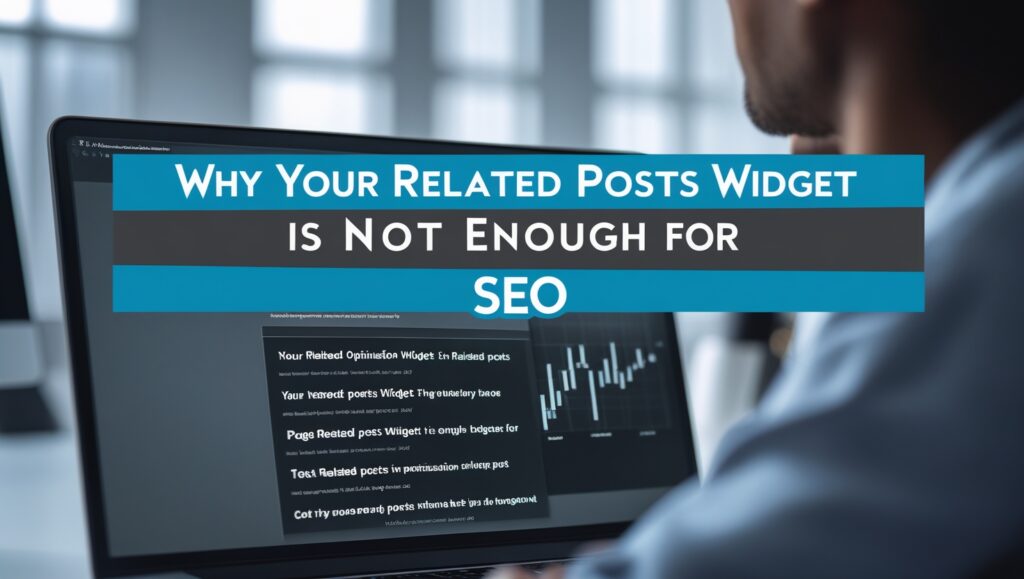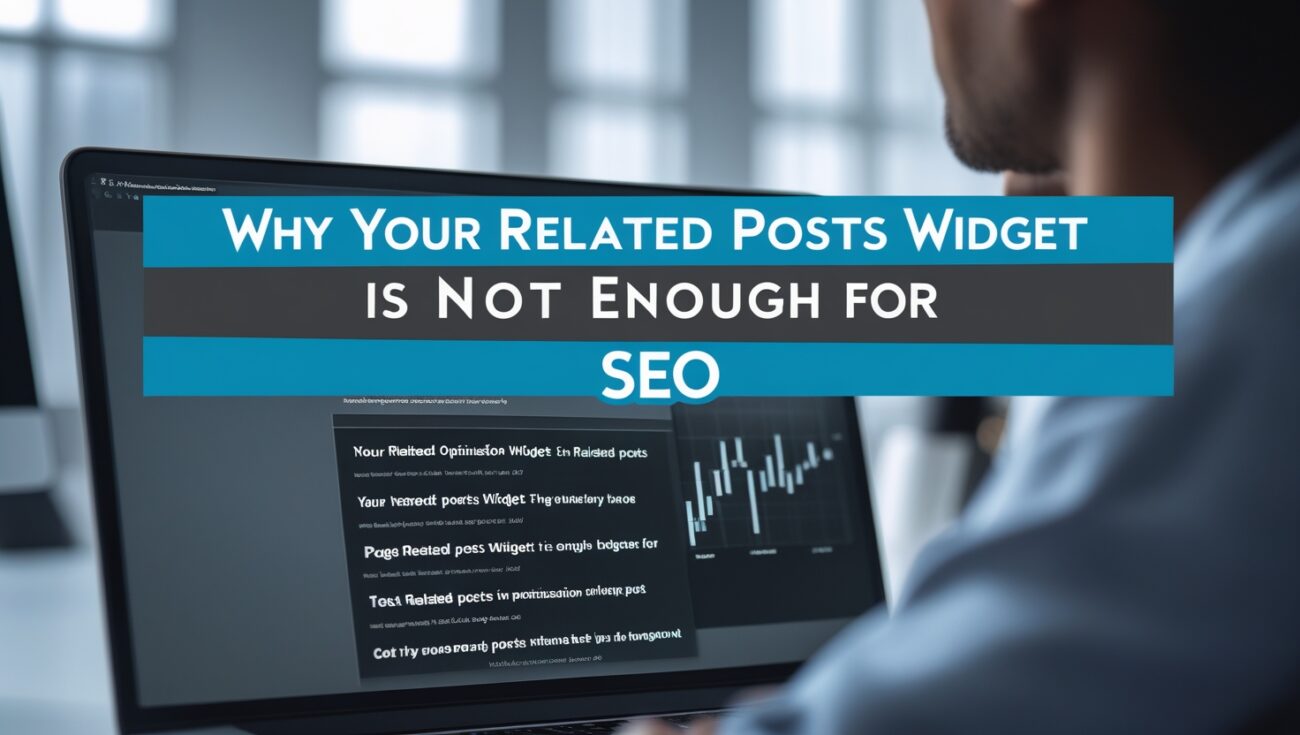Why Your “Related Posts” Widget Is Not Enough for SEO
As a blogger constantly striving to optimize my website, I‘ve explored countless ways to boost engagement and improve search engine rankings. One feature almost every blog platform offers is the seemingly helpful “Related Posts” widget, often found at the end of an article. While these widgets can offer a slight boost in user navigation, relying on them as the cornerstone of your internal linking strategy is a significant SEO oversight.

Table of Contents
I‘ve learned through experience that while these widgets have a place, they simply don’t provide the strategic depth needed to truly leverage the power of internal links for SEO. Thinking they are a complete solution is a common mistake that can leave a lot of ranking potential untapped.
The Limitations of “Related Posts” Widgets
While convenient, “Related Posts” widgets suffer from several key limitations from an SEO perspective:
- Algorithm Dependence: The algorithms that power these widgets are often simplistic, relying heavily on tags or categories. They may not always surface the most relevant content from an SEO standpoint.
- Limited Customization: You typically have little control over which articles are displayed or the anchor text used. This lack of control hinders your ability to strategically pass link equity.
- Placement and Visibility: Located at the end of an article, after the user has already consumed the content, they may be less likely to click. Their impact on key SEO metrics like time on site might be minimal.
- Lack of Contextual Integration: Unlike in-content internal links, “Related Posts” lack the contextual relevance of being woven directly into the narrative of your article. Search engines place higher value on links embedded within relevant content.
- One-Way Street: Often, these widgets are unidirectional, linking from the current page to related pages, but not necessarily back. A strong internal linking strategy involves a reciprocal network of connections.
Thinking these widgets are handling your internal linking is like thinking a suggestion box is a comprehensive customer feedback system – it’s a start, but far from complete.
The Strategic Power of In-Content Internal Linking
True SEO power with internal linking comes from strategically placing relevant links within the body of your content. This offers several advantages that “Related Posts” widgets simply can’t match:
- Contextual Relevance: Links embedded within your text have a high degree of contextual relevance, signaling to search engines the strong topical relationship between the pages.
- Anchor Text Optimization: You have full control over the anchor text, allowing you to use descriptive and keyword-rich phrases that further clarify the link’s purpose to search engines.
- Guiding the User Journey: You can strategically guide readers to specific content you want them to see, nurturing engagement and conversions.
- Distributing Link Equity: You can intentionally pass link equity from high-authority pages to newer or less prominent content, boosting their ranking potential. If you’re looking for a way to identify these strategic linking opportunities, consider exploring the features of Linkbot.
- Building Topical Authority: By consistently linking related content within your articles, you reinforce your expertise on a topic, helping you build valuable content clusters.
Why Automation is Key to a Robust Strategy
Manually building a comprehensive network of in-content internal links across your entire blog can be incredibly time-consuming. This is where automated internal linking software becomes invaluable. These tools can analyze your content and suggest highly relevant in-content linking opportunities that you might otherwise miss. They take the burden of manual searching and linking off your shoulders, allowing you to focus on creating more great content. I’ve found that using Linkbot has significantly improved my in-content linking efficiency.
Conclusion: Go Beyond the Widget for Real SEO Gains
While “Related Posts” widgets offer a basic level of internal navigation, they are simply not enough to form the backbone of a strong SEO strategy. To truly leverage the power of internal linking, you need to focus on strategically embedding relevant links within your content. This provides greater contextual relevance, allows for anchor text optimization, and gives you more control over the flow of link equity.
Don’t rely on a passive widget to handle this crucial aspect of SEO. Take a proactive approach and build a deliberate network of internal links that will significantly boost your search engine rankings and user engagement. If you’re ready to move beyond the limitations of “Related Posts” widgets and implement a powerful, automated internal linking strategy, I highly recommend checking out Linkbot. It’s time to unlock the true potential of your website.
Beyond the direct SEO benefits, a strategic approach to in-content internal linking has a profound impact on user experience. A user who finds a link seamlessly woven into the narrative is much more likely to click it than one who is presented with a generic list at the bottom of the page. This intuitive, helpful navigation contributes directly to the “Experience” part of Google’s E-E-A-T framework, signaling that your website is a high-quality resource.
By taking control of your internal links, you also take control of your site’s crawl budget. Search engine bots follow links to discover and index your content. When your links are strategically placed and highly relevant, the bots can crawl your site more efficiently, ensuring all of your valuable content gets the attention it deserves. A “Related Posts” widget, with its often random suggestions, can lead to a less efficient crawl path.
A well-executed in-content internal linking strategy also helps your pages rank for a wider variety of keywords, especially long-tail keywords. When you link a specific, detailed article to a central “pillar page” and back again, you are creating a strong topical signal. This reinforced relevance allows both the pillar page and the supporting articles to rank for more specific and nuanced search queries, capturing valuable organic traffic.
I’ve come to think of internal linking as a form of “link sculpting.” You are intentionally directing the flow of authority and relevance within your website. This allows you to give a boost to a newer article or to an important page that is struggling to rank. This level of intentionality is simply impossible with a passive “Related Posts” widget.
For mobile users, a clean and logical navigation experience is paramount. A page cluttered with a large “Related Posts” widget can be overwhelming and difficult to use on a small screen. In-content internal links, however, are seamlessly integrated into the text, making them easy to see and click on a mobile device, which provides a much better user experience.
A strong in-content internal link structure is the very foundation of a clean and organized website. It creates a clear hierarchy that is easy for both users and search engines to understand. It signals that your website is not just a collection of random articles, but a well-organized and authoritative resource.
The compounding effect of a consistent in-content internal linking strategy is what truly makes it a hero. Each new link you add is an investment in your site’s future. Over time, these individual links build upon each other, creating a powerful network that will continue to drive organic traffic and boost your rankings long after the initial effort is done.
I‘ve found that having a strategic approach to internal linking also helps with my content calendar. Now, when I plan a new post, I immediately think about how it can be linked to from my most authoritative, existing articles. This ensures that every piece of new content I create contributes to the health of my entire site from day one.
The best automated tools for this task don’t just find links; they give you an actionable “to-do” list. They can identify orphaned pages and suggest the most relevant, high-authority places to link from. This takes the overwhelming nature of the task and turns it into a manageable series of steps, which is invaluable for a busy content creator.
I can say from personal experience that making this one change—from relying on a widget to a strategic in-content approach—has been one of the most impactful changes I‘ve made to my website. It’s transformed my SEO efforts from a passive hope to a proactive strategy that gives me a real sense of control over my site’s destiny.
The long-term ROI of a strategic internal linking plan is undeniable. It’s a foundational SEO tactic that you have full control over, and the benefits—from improved rankings and traffic to a better user experience—are long-lasting and continue to grow over time. The time invested in this strategy is paid back many times over.
Ultimately, “Related Posts” widgets are a good start, but a start is all they are. To unlock the full SEO potential of your website, you need to go beyond the widget and build a deliberate, intelligent network of internal links that makes your content work for you around the clock.

